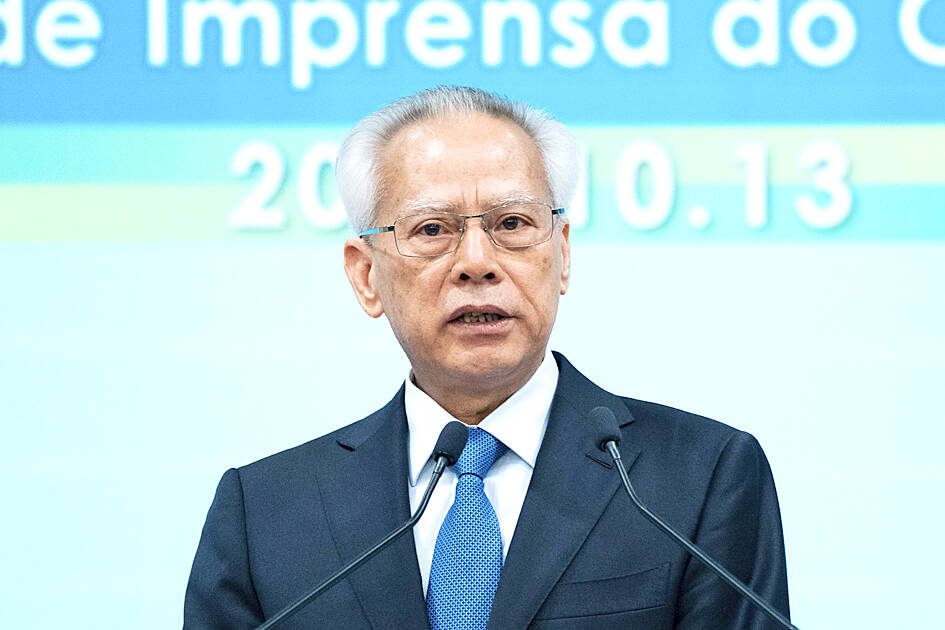Former Macanese judge Sam Hou Fai (岑浩輝), who has warned against the outsize influence of the gambling industry in the city, was elected as its new leader by a 400-member committee.
Sam, 62, the former president of the Macanese Court of Final Appeal, was the sole candidate in the election for chief executive. He received 394 of 398 votes cast yesterday, with the remaining four being blank.
Sam’s victory raises questions about the outlook for the world’s biggest casino market. In August, he warned against the dominant role the gaming centers play in the local economy, saying that “for a period of time, the tourism and gaming industry developed in a disorderly manner and expanded wildly.”

Photo: AP
Having one industry dominate the city “is not beneficial for Macau’s long-term development,” he said.
The growth of casinos had strained resources such as the workforce and even narrowed the career choices for young people, Sam said as he called for diversifying away from the industry.
The former judge’s comments coincided with Beijing launching its latest crackdown on money laundering and capital outflows, a move targeting Macau’s money-exchanging activities.
Over the past few years, the city has imprisoned top junket operators, who brought in high rollers and provided them with credit. Macau has also introduced regulations restricting the agents’ activities, resulting in the collapse of the VIP gambling that once contributed half of the city’s casino revenue.
Outgoing Macanese Chief Executive Ho Iat Seng (賀一誠) had said he would not seek another term for health reasons.
Sam becomes the first person born outside Macau to lead the city. He is a native of the neighboring Chinese province of Guangdong and moved to Macau in the 1980s when the city was administered by Portugal.
He studied at Peking University and the University of Coimbra in Portugal, before becoming a judge in Macau in 1997.

A magnitude 7.0 earthquake struck off Yilan at 11:05pm yesterday, the Central Weather Administration (CWA) said. The epicenter was located at sea, about 32.3km east of Yilan County Hall, at a depth of 72.8km, CWA data showed There were no immediate reports of damage. The intensity of the quake, which gauges the actual effect of a seismic event, measured 4 in Yilan County area on Taiwan’s seven-tier intensity scale, the data showed. It measured 4 in other parts of eastern, northern and central Taiwan as well as Tainan, and 3 in Kaohsiung and Pingtung County, and 2 in Lienchiang and Penghu counties and 1

FOREIGN INTERFERENCE: Beijing would likely intensify public opinion warfare in next year’s local elections to prevent Lai from getting re-elected, the ‘Yomiuri Shimbun’ said Internal documents from a Chinese artificial intelligence (AI) company indicated that China has been using the technology to intervene in foreign elections, including propaganda targeting Taiwan’s local elections next year and presidential elections in 2028, a Japanese newspaper reported yesterday. The Institute of National Security of Vanderbilt University obtained nearly 400 pages of documents from GoLaxy, a company with ties to the Chinese government, and found evidence that it had apparently deployed sophisticated, AI-driven propaganda campaigns in Hong Kong and Taiwan to shape public opinion, the Yomiuri Shimbun reported. GoLaxy provides insights, situation analysis and public opinion-shaping technology by conducting network surveillance

Taiwan is gearing up to celebrate the New Year at events across the country, headlined by the annual countdown and Taipei 101 fireworks display at midnight. Many of the events are to be livesteamed online. See below for lineups and links: Taipei Taipei’s New Year’s Party 2026 is to begin at 7pm and run until 1am, with the theme “Sailing to the Future.” South Korean girl group KARA is headlining the concert at Taipei City Hall Plaza, with additional performances by Amber An (安心亞), Nick Chou (周湯豪), hip-hop trio Nine One One (玖壹壹), Bii (畢書盡), girl group Genblue (幻藍小熊) and more. The festivities are to

Auckland rang in 2026 with a downtown fireworks display launched from New Zealand’s tallest structure, Sky Tower, making it the first major city to greet the new year at a celebration dampened by rain, while crowds in Taipei braved the elements to watch Taipei 101’s display. South Pacific countries are the first to bid farewell to 2025. Clocks struck midnight in Auckland, with a population of 1.7 million, 18 hours before the famous ball was to drop in New York’s Times Square. The five-minute display involved 3,500 fireworks launched from the 240m Sky Tower. Smaller community events were canceled across New Zealand’s